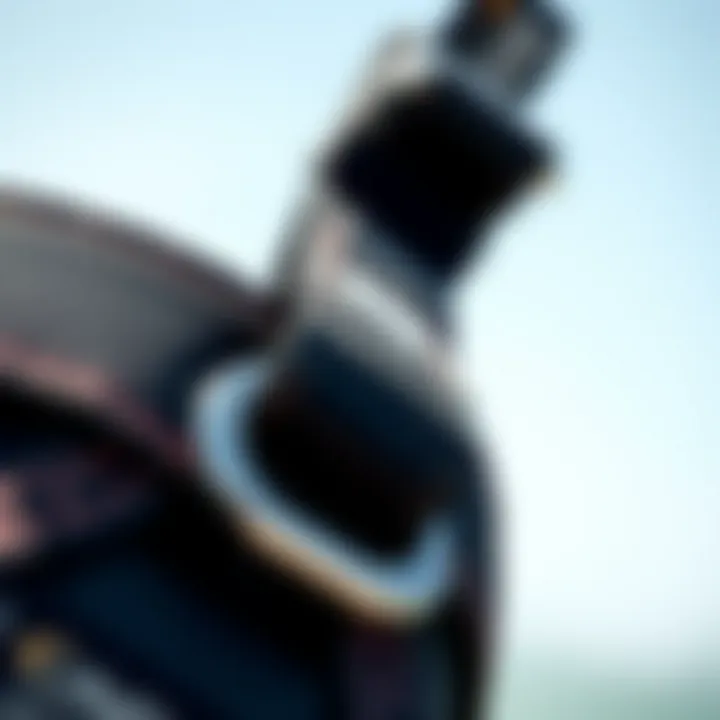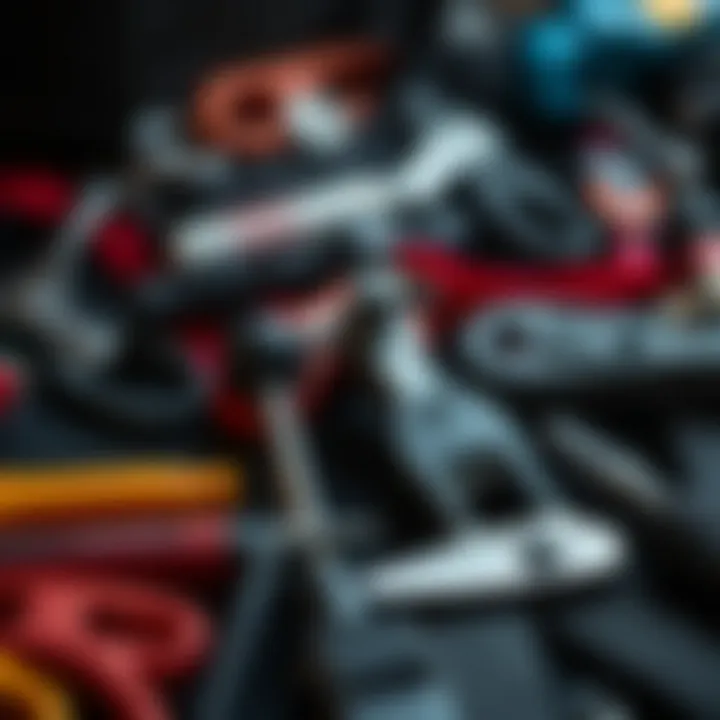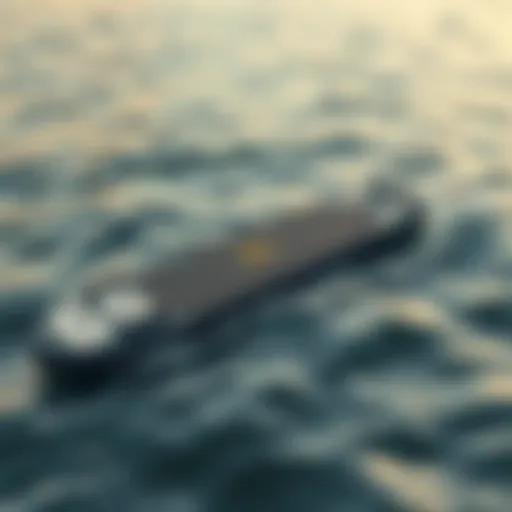Comprehensive Guide to Kitesurfing Harnesses for Sale


Intro
Kitesurfing, with its exhilarating mix of wind and waves, is a sport that attracts adventurers from all walks of life. Whether you’re a seasoned pro or a fresh-faced newbie, one crucial piece of equipment that demands careful consideration is the kitesurfing harness. This guide aims to unravel the mysteries behind the various harnesses available on the market, helping kiteboarders make informed choices tailored to their unique needs and riding styles.
Harnesses do more than just secure you to the kite; they play a significant role in distributing the force exerted by the lines across your body. A good harness can enhance your performance, comfort, and overall enjoyment on the water, while a poor fit can lead to discomfort and even injury. In this article, we’ll delve into the types of harnesses, their materials, features, and much more. By the end of this read, readers will have a concrete understanding that facilitates the perfect selection of a kitesurfing harness.
Gear Insights
The world of kitesurfing harnesses is as diverse as the sport itself, with numerous options available, each claiming to be the best. Understanding what to look for can be a bit like searching for a needle in a haystack, but fear not; we’re here to provide clarity.
Latest Gear Reviews
As technology progresses, so does the equipment. Recent reviews indicate several standout models in the market. For instance, the Duotone Entity harness has garnered attention for its comfort and performance. Built with soft materials, it is designed to mold perfectly to the body shape.
Another worth noting is the ION Nova, which offers a great balance for both freestyle and wave riding, appealing to a broad range of kiteboarders. Its lightweight construction and secure fit allow for movement without feeling constricted.
While reading reviews, always consider user feedback on factors like comfort, durability, and fit.
Essential Gear for Beginners
For those just starting out, the right harness can make all the difference. Look for a harness that boasts ample padding yet remains lightweight – something like the Prolimit Kite Seat Harness can be a fine fit. This choice usually provides more security and support.
When learning, it's also essential to avoid the pitfalls of a harness that fits poorly. Ensure the harness sits comfortably above the hips and doesn’t dig into your sides. Here are some tips when selecting your first harness:
- Try before you buy: Whenever possible, try on different models to see what feels best.
- Seek advice: Engage with local kiteboarding communities or instructors to get insight into what works for beginners.
- Consider adjustability: Look for harnesses that have adjustable straps to fine-tune the fit as you grow.
Techniques and Tips
As your skills develop, it’s crucial to keep the right techniques in mind for both usage and safety.
Advanced Tricks and Techniques
Once you’ve got the basics down, you might want to explore more advanced tricks. Having a well-fitted harness can certainly boost your confidence while attempting aerial maneuvers, such as jumps or spins. Make sure that your harness doesn’t restrict your movements while you're mastering your skills.
Safety Practices for Kiteboarders
Safety in kitesurfing cannot be stressed enough. Always check your harness for wear and tear, particularly after a fall or hard landing. The last thing you want is a broken harness when you're out on the water. Remember:
- Inspect regularly: Look for any fraying or weak spots in the straps or buckles.
- Practice self-rescue: Regardless of your harness choice, knowing how to manage risks in various water conditions is crucial for safety.
"Proper fitting of your harness not only enhances comfort but is vital for safe kitesurfing."
Preamble to Kitesurfing Harnesses
When a rider takes to the open water, the kitesurfing harness often becomes a vital bridge between them and the kite itself. Ultimately, it’s not just about holding on for dear life; the harness plays a critical role in the overall dynamic of the sport. Without it, managing the power generated by the kite would be near impossible.
Kitesurfing harnesses vary in type, design, and material, which can greatly affect a rider's performance and comfort level. They are more than just equipment; they can influences one's riding experience significantly. Finding the right harness doesn’t merely elevate performance; it blends safety with enjoyment, allowing a rider to focus on the thrill without wrestling with their gear.
Navigating through the sea of choices may seem daunting, especially for beginners. However, understanding the various types and features of kitesurfing harnesses can ease the purchasing process, ensuring riders select a harness that aligns with their style and needs. In this section, we’ll break down the basic elements to grasp the importance of choosing the right harness, introducing key aspects of kitesurfing harnesses that can't be overlooked.
Understanding the Role of a Harness in Kitesurfing
A harness in kitesurfing acts like a seatbelt in a car. It secures the rider, spreading the kite's force evenly across the body to avoid strain and enhance control. This is particularly important when experiencing strong winds or attempting jumps and tricks. When used correctly, it can also prevent injuries by distributing pressure away from concentrated areas, allowing for a more enjoyable ride.
Types of Kitesurfing Harnesses
The market for kitesurfing harnesses is diverse. Each type caters to different preferences and riding styles. Understanding these types is key to making an informed decision. Here are the most common types:
Waist Harness
A waist harness is, as the name suggests, worn around the waist. It’s by far the most popular choice among many riders, and it's not hard to see why. The main aspect that sets this harness apart is its slim profile which provides a high degree of mobility. This allows riders to execute maneuvers with finesse.
One key characteristic of the waist harness is its ability to connect the spreader bar at the waist level, giving a rider a better leverage for lifting and steering the kite. This efficient use of body mechanics contributes significantly to how well a rider can harness the kite's power.
However, it’s not without downsides in specific scenarios. Riders, particularly those who are heavier or have a fighting spirit in the waves, might experience discomfort or bruising if the harness is not adjusted properly. It’s crucial to ensure it fits well and is suited for one’s riding style.
Seat Harness
Conversely, the seat harness sits lower, wrapping around the hips and offering additional support to the lower body. This can be particularly helpful for beginners. Its design tends to alleviate the strain off the lower back, providing a stable platform from which to ride.
The seat harness is known for distributing weight more evenly, making it a solid option for riders looking to stay planted in strong winds or those practicing moves where stability is paramount. However, the trade-off often comes in the form of limited movement, which some more experienced riders might find restrictive.


Impact Vest
Impact vests intersect with the traditional harness but incorporate protective padding. This is essential for those who fully embrace the thrills of kitesurfing, where falls and crashes can inevitably happen. A well-designed impact vest melds comfort with safety, giving peace of mind during high-stakes maneuvers.
Most importantly, it provides buoyancy which can be an added safety measure in rough waters. That said, they’re generally bulkier than other harness types, which could hinder performance slightly, but many find the trade-off worth their added protection.
Ultimately, selecting the right kitesurfing harness involves understanding personal preferences as well as the type of riding one engages in. A well-chosen harness not only enhances comfort and safety but also elevates the overall experience on the water.
Key Features to Consider When Buying a Harness
When it comes to kitesurfing, selecting the right harness is just as crucial as choosing the appropriate kite. A harness that fits well and is made of quality materials ensures not only comfort but also safety during your ride. Since harnesses come in various designs and constructions, understanding the key features can act as your compass, guiding your purchase decisions effectively. This section will explore aspects such as material construction, spreader bar options, and comfort features, helping you find a harness that meets your specific needs.
Material Construction
Nylon
Nylon is a widely utilized material in the construction of kitesurfing harnesses due to its strength and durability. Nylon harnesses are generally known for being lightweight, allowing for a swift and responsive experience on the water. One of the key characteristics of nylon is its resistance to abrasion, which is especially beneficial for kitesurfers who often encounter harsh conditions. Additionally, nylon's water-resistant properties help in keeping the harness intact during wet rides.
However, it has a knack for becoming slippery when wet, which could pose a challenge if the design lacks adequate grip features. Overall, nylon harnesses are popular due to their balance of performance and longevity.
Neoprene
In terms of flexibility and comfort, neoprene harnesses shine brightly. Known for their stretchable and snug fit, these harnesses mimic the body's movements, making them ideal for dynamic kitesurfing stunts. The insulating properties of neoprene also provide warmth in cooler waters, making it a prime choice for those willing to surf in various climates.
On the flip side, neoprene can necessitate a bit more care when drying, as it tends to retain water and heat. While it does offer an encompassing feel, some might find it too constricting if fitted incorrectly.
Composite Materials
More recently, manufacturers have started experimenting with composite materials that blend various fabrics for enhanced performance. These materials can include blends of nylon, polyester, and sometimes (but not always) breathable mesh. One notable benefit of using composite materials is the ability to engineer a harness that reflects the combined strengths of different materials. For example, while maintaining lightweight properties, they can also enhance ventilation and moisture control.
That said, composite harnesses may come with a higher price tag and can require more detailed maintenance since the various components can wear differently. It's a trade-off many serious kitesurfers are willing to make for that extra performance edge.
Spreader Bar Options
Fixed Spreader Bars
Fixed spreader bars represent a classic option in harness design, offering simplicity and reliability. By providing a solid connection point between your harness and the kite lines, fixed spreader bars allow for immediate response—a necessity for any kitesurfer navigating waves or gusts. These are generally easier to set up, making them a popular choice among beginners.
However, being fixed means the adjustments might not allow for the optimal position for every rider. Those with specific riding styles may find the lack of customization a limitation, turning to alternatives when they find that perfect fit.
Sliding Spreader Bars
On the other hand, sliding spreader bars offer greater freedom of movement. When connected to a harness, this design allows the spreader bar to slide along the harness lines, which can be advantageous when performing tricks or in challenging weather conditions.
The key attribute of sliding spreader bars is that they can alleviate some of the pressure on the lower back during heavy loads. This can lead to a more comfortable ride, especially for those looking to push their limits in style. The downside? Setup might be more complex, and there’s a bit of a learning curve to get used to their dynamics.
Padding and Comfort
Cushioning Materials
Cushioning plays a vital role in how comfortable your harness feels, especially during extended rides. A well-cushioned harness will often include foam padding, but the type and density can vary widely. High-density foam, for instance, provides excellent shock absorption while maintaining an appropriate firmness under pressure—like a firm mattress but without the back pain.
Also, some harnesses utilize varying materials for the ultimate comfort, blending softer materials with firmer ones to provide optimum support where it's needed most. But be cautious; too much padding can lead to overheating and discomfort, especially in warmer climates.
Ventilation
Ventilation is another crucial factor that might get overlooked. A harness that lacks proper ventilation can become a personal sauna during the hotter days at the beach. Harnesses designed with mesh panels allow airflow, enhancing comfort and preventing excess heat accumulation. This feature is particularly useful for kitesurfers who veer more toward all-day sessions customarily.
However, keep in mind that while ventilation is vital, it should not come at the cost of overall structural integrity. Those flying high or tackling tight turns should look for that balance of support and breatheability.
Choosing a harness is not just about the design or brand; it’s about finding what works best for you and your kitesurfing style.
By considering these key features, you are better equipped to buy a harness that complements your skills and experience out on the water. Each decision you make will ripple through your kitesurfing journey, making it even more enjoyable.
Finding Quality Kitesurfing Harnesses for Sale
When diving into the world of kitesurfing harnesses, knowing where to shop can be just as vital as the harness itself. The right gear can make or break your experience on the water, and finding quality harnesses is essential for both performance and safety. With so many options available, understanding the avenues for purchasing these harnesses is crucial—not just for beginners who might be overwhelmed, but also for seasoned pros looking to upgrade their gear.
Online Retailers
One of the simplest ways to access a vast selection of kitesurfing harnesses is through online retailers. Expect to find a broad array of products, from basic models to high-end gear, all at your fingertips. The convenience of browsing from home allows you to compare various types and features while reading reviews from others who have already taken the plunge.


E-commerce Platforms
E-commerce platforms like Amazon and eBay have revolutionized the shopping experience, making it easy to find kitesurfing harnesses. These platforms are characterized by extensive user reviews and competitive pricing, which help you make informed choices.
The massive selection is one key feature that attracts many buyers. You can easily filter options based on size, style, and price range. However, a notable downside is that you may not always receive personalized customer service, leaving some types of questions unanswered.
"When buying kitesurfing gear online, consider shipping fees and return policies. It's worth ensuring you can easily return or exchange an item if it doesn’t fit right."
Specialized Kiteboarding Shops
On the other hand, specialized kiteboarding shops online offer another layer of expertise. Websites like Kiteboarding.com or TheKiteShop.com often have dedicated sections for harnesses with in-depth descriptions and technical specifications. This specificity allows buyers to delve deeper into features that align with their kitesurfing style.
Such shops often provide a tailored experience, which is a significant advantage. They might even offer expert advice through live chats or comprehensive guides. The drawbacks could include less variety compared to larger e-commerce platforms, but the depth of knowledge available helps inform purchasing decisions.
Local Stores and Brands
Though online shopping has its benefits, local stores offer a unique flair by giving you hands-on experience with products. There’s something deeply satisfying about physically examining gear before buying, which is especially true for kitesurfing harnesses that rely heavily on fit and comfort.
Benefits of Shopping Locally
Shopping locally allows you to feel the materials, try on different sizes, and consult with knowledgeable staff. This tactile approach can enhance your understanding of what to look for in a harness, thereby improving your eventual purchase.
Community connections also come into play, as buying from local shops can help support local businesses. While local stores may have a limited selection and higher prices due to overhead costs, the personalized service and immediate availability are often worth it.
Recommended Local Shops
Local shops like "Kitemare" or "Lift Kiteboarding" can offer a wealth of options. What sets them apart is a genuine interest in ensuring customers leave satisfied. They often provide products suited for the local kitesurfing conditions, offering gear tailored to the area's specific demands.
While the selection might not rival larger online platforms, the intimacy and service in these shops can make a significant difference in your kitesurfing journey. Plus, engaging with community events or workshops can enhance your skills and network within the kiteboarding community.
In summary, identifying where to find quality kitesurfing harnesses—be it through online retailers or local shops—plays a pivotal role in enhancing the overall kitesurfing experience. By balancing convenience with personalized guidance, you'll be well-positioned to make an informed purchase that suits your needs.
Considerations for First-Time Buyers
When stepping into the world of kitesurfing, choosing the right harness is paramount. For first-time buyers, this decision can set the stage for a more enjoyable ride or, conversely, a drawn-out struggle with discomfort and inefficiency. Harnesses are not just gear; they are the connection between your body and the kite, affecting control, stability, and overall performance.
Sizing and Fit
Measuring Techniques
Getting the size just right for a harness is akin to finding the perfect pair of shoes; it’s all about snugness without binding. Start by measuring your waist where the harness will sit, using a flexible tape measure for accuracy. This method is not just a fleeting trend; it’s an essential step that influences how well the harness will perform.
A key characteristic of proper measuring techniques is their emphasis on precision. A few inches off can lead to uncomfortable rides or, worse, accidents on the water. Plus, many harnesses come with sizing charts that help you find your fit based on your measurements. One unique element about measuring is the ability to account for your body type; various harness brands may have different sizing standards. Therefore, always cross-check with manufacturer guidelines.
In this article, addressing sizing concerns provides invaluable help to kitesurfers. An adequately fitting harness ensures comfort and minimizes fatigue during long sessions.
Adjustability Features
Adjustability is another significant aspect of harness selection. A harness should not only fit well initially but also allow for some leeway as your body changes, whether from seasonal fluctuations or fitness gains. Popular harenss come equipped with adjustable straps, making it easy to fine-tune the fit once you're out on the water.
These adjustable features offer diverse benefits. For instance, when learning various kitesurfing techniques, you might prefer different tightness levels for better response or support. Also, adjustable harnesses are really practical for sharing among friends or family—no need to buy for each.
However, a potential downside could be that with numerous adjustment spots, it might take a learning curve to figure out the right balance for optimal performance. But once mastered, these harnesses can significantly enhance your kitesurfing experience.
Safety Standards
Certification Labels
One must not overlook safety when purchasing a harness. Look for certification labels that indicate the product meets certain industry benchmarks for reliability and functionality. These labels serve as a clear indicator that a harness has gone through rigorous testing, ensuring it can withstand the stresses of kitesurfing.
A core characteristic of certification labels is their standardization, which means you can trust manufacturers who comply with these safety measures. Therefore, focusing on this aspect helps shield yourself from subpar products that could spell disaster during a session.
Additionally, the uniqueness of certification labels lies in their transparency—each label corresponds to specific testing criteria and limitations of the product. With such information, kitesurfers can make educated decisions about which harness will keep them safe.
Industry Recommendations
Finally, industry recommendations can be powerful allies in your quest for the right harness. Professional kitesurfers and instructors often have insights into which harnesses withstand the test of time and perform well under pressure. Recommendations can highlight harnesses that may not be on the mainstream market yet, potentially leading you to discover hidden gems.
The appealing aspect of recommendations is that they come from personal experiences. They often outline the nuances that specs alone won't reveal—like how a harness feels after a few hours of use or its performance in various conditions.
However, the drawback might come if one becomes overly reliant on recommendations without considering one’s own body shape and preferences. What fits one person like a glove may feel like a straight jacket for another. Thus, while these recommendations are valuable, they should be just one part of your decision-making process.


Ultimately, as a first-time buyer, understanding sizing, safety standards, and adjustability features will enhance your confidence in choosing the right kitesurfing harness.
Maintaining Your Kitesurfing Harness
A kitesurfing harness is not just a piece of equipment; it’s a lifeline that connects you to your kite and ultimately, the water. Therefore, maintaining your harness is not merely advisable—it’s essential. A well-maintained harness ensures not only longevity but also optimal performance and safety. When you invest time and effort in upkeep, you can be sure that you’re making the most of your kitesurfing experience.
Cleaning and Care
Proper Washing Techniques
Proper washing techniques for kitesurfing harnesses are crucial to keeping them in good shape. After each kitesurfing session, rinsing your harness with fresh water becomes necessary. Saltwater and sand can wear on materials, leading to quicker degradation. Using a mild soap can further help remove stubborn stains or salt crust that may form. When it comes to washing, it’s best to use a gentle, cold-water cycle if a machine is involved.
One key characteristic of proper washing techniques is that they help to preserve the elasticity of harness materials. For instance, nylon and neoprene are popular in harness construction, and these fabrics can lose their structure if not cleaned correctly. What stands out about this method is that it tends to extend the lifespan of your harness, which translates into less frequent replacements—an economical and practical choice for any kiter. However, a disadvantage might be that some manufacturers recommend against machine washing altogether, so always check the specific care instructions.
Storage Guidelines
When it comes to storage guidelines, the approach you take can influence your harness's durability and functionality. Store your harness in a cool, dry place and away from direct sunlight. Prolonged exposure to UV rays can lead to material degradation, especially in harnesses made from synthetic fabrics. Hanging the harness, if possible, is an excellent option as it helps maintain its shape.
A prominent characteristic of proper storage is its ability to prevent mold and mildew. If moisture lingers in the harness, it can lead to unwanted odors and can even affect the integrity of the materials. One unique feature of proper storage is that it allows you to ascertain that all parts—like buckles and spreader bars—are in good condition before your next adventure. However, neglecting these storage recommendations might result in unexpected surprises when you reach for it on your next trip.
Repairing Common Issues
Identifying Wear and Tear
Identifying wear and tear in your kitesurfing harness is essential for ensuring safety while you’re out on the water. Over time, various elements can create signs of stress—a frayed strap, cracked buckles, or faded padding are worth noting. This vigilance can prevent equipment failure at crucial moments, which could lead to accidents.
One key characteristic of effective wear identification is to develop a routine inspection habit, perhaps even after each session. Regular checks will build deeper awareness of your harness’s condition. The advantage here is that early detection of these issues can often lead to simple repairs rather than expensive replacements. On the flip side, wear is sometimes not immediately visible, which means that some savvy kiteboarders miss small but significant signs of damage.
DIY Repair Methods
DIY repair methods can save you both money and time, making them a worthwhile part of your maintenance routine. Basic repairs—be it stitching a loose strap or replacing a broken buckle—are often simpler than most would think. A sewing kit and some marine adhesive can go a long way in extending the life of your harness.
One notable characteristic of DIY repairs is their accessibility. You won’t have to wait weeks for professional service or spend a fortune on expert help. Knowledge gained from performing these repairs fosters a deeper bond with your gear and boosts confidence in handling future issues. However, some might argue that improper repairs made at home could lead to more complicated issues down the line, especially if the repairs compromise safety. Being mindful and educated about repair techniques is imperative to avoid this risk.
Latest Trends in Kitesurfing Harness Technology
In the ever-evolving world of kitesurfing, harness technology plays a pivotal role in enhancing performance and safety. As kiteboarding continues to grow, so do the innovations in harness design and materials. These advancements are not just about aesthetics; they represent a fundamental shift in how harnesses function, providing kitesurfers with better control, efficiency, and overall experience. Understanding these trends can be the difference between a mediocre session and an exhilarating ride on the water.
Innovative Materials
Lightweight Options
The push towards lightweight options in harness design has gained significant traction in the past few years. Lightweight materials allow for a more agile experience in the water, enabling riders to execute tricks and maneuvers with greater ease. For instance, many modern harnesses utilize advanced fabrics such as Dyneema or high-tenacity nylon blends. These materials not only reduce the overall weight of the harness but also offer increased durability against wear and tear.
One of the standout characteristics of lightweight harnesses is their comfort during extended use. They allow for a natural body movement without adding unnecessary bulk or dragging through the water. However, some might argue that lighter materials can compromise support. Nonetheless, manufacturers are continuously finding ways to marry lightweight design with adequate support, making the benefits of lightweight options hard to ignore.
Eco-Friendly Materials
Amid rising ecological awareness, eco-friendly materials have started making their mark in the kitesurfing industry. These materials often feature recycled plastics or organic fibers that not only provide robust performance but also lessen the ecological footprint of the sport. As these harnesses become more mainstream, consumers can choose products that align with their values while enjoying the thrills of kitesurfing.
The standout characteristic of eco-friendly harnesses is their commitment to sustainability, which resonates with environmentally conscious kiteboarders. Harnesses crafted from recycled materials typically retain a high quality, which is crucial when choosing equipment that must endure harsh conditions. Nonetheless, some users have raised concerns regarding the longevity of these materials compared to traditional options. Yet, advancements in technology continuously challenge the notions of durability, ensuring eco-friendly options are viable substitutes.
Smart Harness Features
Integrated Safety Systems
One of the most valuable advancements in kitesurfing harnesses is the introduction of integrated safety systems. These systems are designed to enhance safety for riders, providing features such as automatic quick-release mechanisms. Such innovations can be life-saving, especially in emergency situations where swift action is required.
The key characteristic of integrated safety systems is their ability to simplify user interaction. Riders find peace of mind knowing that safety is built directly into the harness, minimizing the likelihood of human error. However, with the added complexity of these features, some may find them difficult to operate, especially if they haven't gained familiarity with the system. Despite this, the added safety benefits are a strong argument in favor of these advanced harnesses.
Performance Tracking Devices
The incorporation of performance tracking devices into kitesurfing harnesses signals an exciting leap forward for technology and personal improvement. These devices can monitor aspects such as speed, jump height, and duration, providing valuable data that can be analyzed to enhance performance. For kiteboarders eager to take their skills to the next level, having access to real-time analytics is invaluable.
What makes performance tracking devices a beneficial trend is their capacity to facilitate data-driven training. They allow riders to set measurable goals and track progression over time. That said, there’s a potential drawback: the reliance on technology. Some purists argue that kitesurfing is best enjoyed with less emphasis on metrics and more on the experience itself. Still, for those who crave improvement, these devices provide crucial insights that can turn a good kiteboarding session into a great one.
The intersection of cutting-edge technology and kitesurfing harnesses not only elevates the sport but also prioritizes the safety and performance of every rider.
Culmination
The choice of a kitesurfing harness is critical. It shapes not only the entire kitesurfing experience but also has a direct impact on performance and safety on the water. In the bustling world of kiteboarding, where every ounce of control matters, selecting the right harness can mean the difference between soaring triumph or bruising failure.
Summarizing the Importance of Choosing the Right Harness
Understanding the nuances of different harness options is paramount for both enthusiasts and novices alike. Here are a few key points to consider:
- Comfort and Fit: A harness that fits well can enhance your time on the water significantly. If it pinches or shifts unnaturally, it can divert your focus and enjoyment. Therefore, assess how different models press against your body and make adjustments according to your needs.
- Performance Benefits: The right harness facilitates better control. Whether you're performing jumps or navigating strong winds, a harness that provides supportive tension can greatly aid your maneuvers.
- Safety Features: Emphasizing safety is not just about looking cool in your gear. Ensure that your harness has a secure locking mechanism and any additional features that can assist in potential emergencies. Certifications can guide you toward safer choices.
- Material Durability: With kiteboarding, the elements can be harsh. A harness made from robust materials will withstand wear and tear, allowing you to focus on what you love – riding the waves.
- Innovation and Development: The kitesurfing industry is ever-evolving, with new technology and materials being introduced each season. Keeping up-to-date with trends allows you to make an informed decision about what will work best for you.
To conclude, the kitesurfing harness you select affects your overall enjoyment, safety, and control in the water. From understanding different types, sizing properly, to looking for the latest advancements in safety and comfort, each of these elements is woven into the larger tapestry of kitesurfing. So, heed the wisdom shared and make a choice that strikes the perfect balance for you. After all, your harness should feel like an extension of yourself, not just equipment you strap on.















